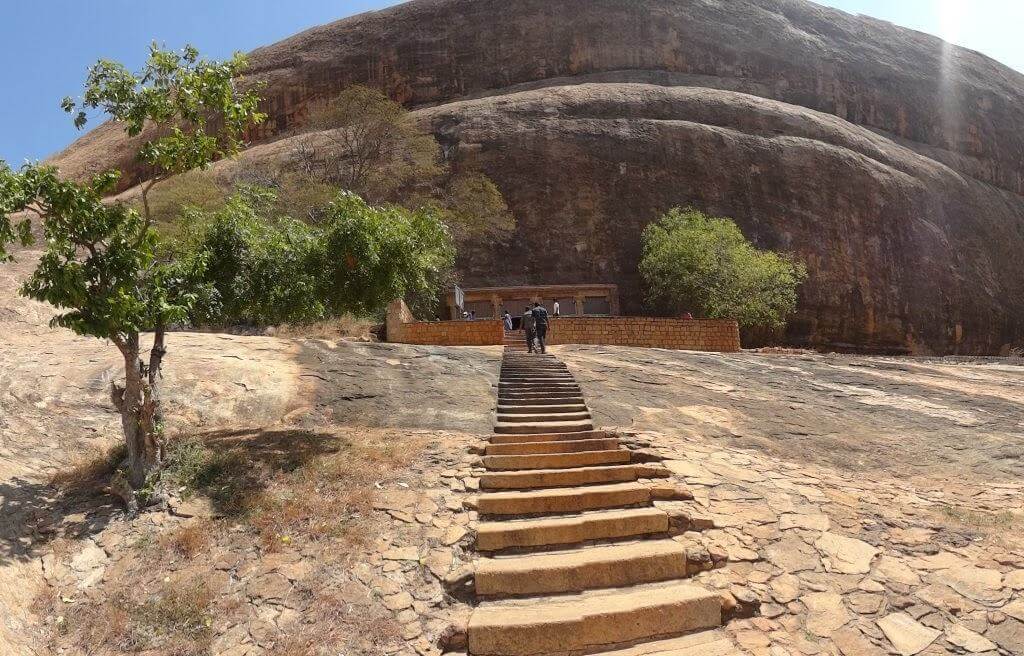Sri Sithannavasal Rock-Cut Jain Temple, Pudukottai

Address
Sri Sithannavasal Rock-Cut Jain Temple Sithannavasal, Cave Road, Madiyanallur, Pudukottai district Tamil Nadu 622101
Diety
Tirthankaras
Introduction
Sittanavasal Cave (also, ArivarKoil) is a 2nd-century Jain complex of caves in Sittanavasal village in Pudukottai district of Tamil Nadu, India. Its name is a distorted form of Sit-tan-na-va-yil, a Tamil word which means “the abode of great saints”. The monument is a rock-cut monastery or temple. Created by Jains, it is called the ArivarKoil, and is a rock cut cave temple of the Arihants. It contains remnants of notable frescoes from the 7th century. The murals have been painted with vegetable and mineral dyes in black, green, yellow, orange, blue, and white. Paintings have been created by applying colours over a thin wet surface of lime plaster. Ancient structures such as GolGumbaz, Talagirisvara temple and this one are claimed to be relatively unappreciated.Archaeological Survey of India has listed Sittanavasal Cave in the list of “Must See” Indian Heritage
Puranic Significance
While the Sittanavasal village is dated from 1st century BC to 10th century AD when Jainism flourished here, the Temple-cave was initially dated to Pallava King Mahendravarman I (580–630 AD) prior to his conversion from Jainism to Hinduism as a Shaivite. However, an inscription attributes its renovation to a Pandyan king probably MaranSendan (654–670 AD) or ArikesariMaravarman (670–700 AD).The Jain beds on the hill top is attributed to the Jain era pilgrimage centre which lasted till the 9th century AD. However, in the Pudukkottai region, where the monuments are located, there are many archaeological finds of the megalithic burial sites from much earlier. There are two publications in the 20th century which brought to light these monuments in particular: one in 1916, in the book “General History of the Pudukkottai State” by S. RadhakrishnaIyer, a historian, but only known regionally; and the other by Jouveau-Dubreuil and Gopinatha Rao, iconographers who worked together and brought out a “Monograph on Sittannavasal”, in 1920, which brought it to limelight among archaeologists worldwide. The cleaning of the painting was undertaken in 1942 by Dr. S. Paramasivan and K. R. Srinivasan when they observed a patch of old painting of conventional carpet design superimposed by a new layer of painting. The superimposed layer of painting has been surmised as that done Ilan-Gautaman, whose name is also inscribed.The temple is maintained and administered by the Archaeological Survey of India as a ticketed monument At the initiative of Pudukkottai State, during 1937–39, the paintings were cleaned, and then given a preservative coating. Also, the damaged portions of the plastering were injected with cementing material and the paintings were also retouched.
Special Features
Sittanavasal is a rock-cut cave, situated on the western side of central part of a hill, which runs in a north-south direction. The hill measures approximately 70 metres (230 ft) in height, and sits above the surrounding plain which has some archaeological monuments. The Jain natural caverns, called Ezhadippattam are approached from the foothills. The cave is approached by climbing a few 100 steps
Century/Period/Age
2nd-century
Managed By
Archaeological Survey of India
Nearest Bus Station
Sithannavasal
Nearest Railway Station
Pudukottai
Nearest Airport
Trichy




